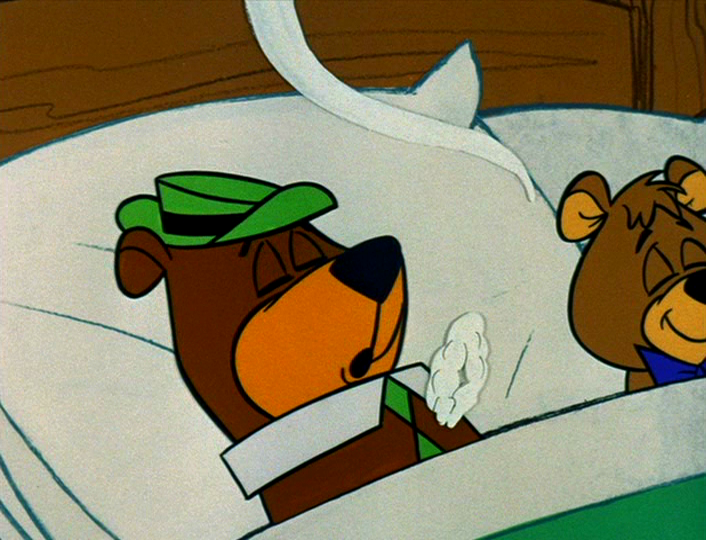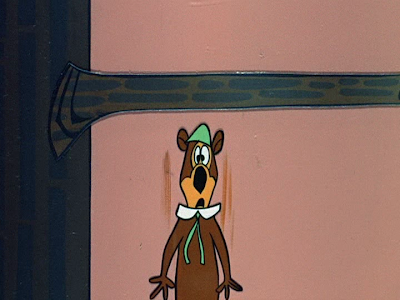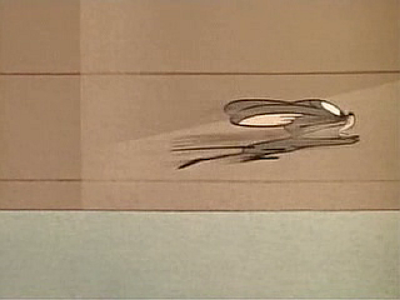Produced and Directed by Bill Hanna and Joe Barbera.
![]() Credits: Animation – Bob Carr; Layout – Tony Rivera; Backgrounds – Dick Thomas; Written by Warren Foster; Story Director – Alex Lovy; Titles – Art Goble; Production Supervision – Howard Hanson.
Credits: Animation – Bob Carr; Layout – Tony Rivera; Backgrounds – Dick Thomas; Written by Warren Foster; Story Director – Alex Lovy; Titles – Art Goble; Production Supervision – Howard Hanson.
Voice Cast: Narrator, Boo Boo, Ranger Smith, black-haired Scout – Don Messick; Yogi Bear, Scout lighting fire, tall ranger, red-haired Scout, Scoutmaster – Daws Butler.
Music: Jack Shaindlin; Spencer Moore; Bill Loose/John Seely.
First aired: week of February 6, 1961 (Yogi Bear Show)
Plot: Yogi and Boo Boo disguise themselves as members of the Bear Patrol to get food from camping Boy Scouts.
![]() When Warren Foster had Bugs Bunny draw a line in the sand and dare Yosemite Sam to step across it, you knew it would end in disaster for Sam and something pretty funny. In “Cub Scout Boo Boo), Warren Foster has Ranger Smith draw a line and, well, it’s kind of forgotten as the plot wears on.
When Warren Foster had Bugs Bunny draw a line in the sand and dare Yosemite Sam to step across it, you knew it would end in disaster for Sam and something pretty funny. In “Cub Scout Boo Boo), Warren Foster has Ranger Smith draw a line and, well, it’s kind of forgotten as the plot wears on.
Not only does Yogi blatantly ignore the law (Smith), but he takes food from innocent children by impersonation. And he gets away with it.
We’ll let do-gooder groups stew over that for a bit. In the meantime, there’s not an awful lot to say about this particular cartoon. The animation’s basic (Bob Carr saves work in some walking sequences by only showing the upper part of the body, negating the need to animate leg movements), Tony Rivera designs characters with pipe-stem legs and Dick Thomas sticks with a basic colour scheme (sky is blue, grass is green, wood is brown). I do like one background where he’s got various shades of green to indicate rows of trees going into the distance.
![]()
And Foster’s story line starts typically. Opening narration over some of Thomas’ paintings (with some effect animation), a medium pan over a background drawing (snipped together; you can see the jump in it) and a bunch of Yogi rhymes. The premise is Bill Hanna’s beloved Boy Scouts are holding a jamboree at Jellystone. The smell of their campout wafts into Yogi and Boo Boo’s cave. The first gag is Yogi breathing in the fumes as he snores and exhaling them (seems I saw something similar in an early Fleischer Talkartoon). Yogi runs for the food. “A weenie roast is the very most. And a hamburger bun is a lot of fun,” rhymes Yogi. And we get some plays on words “And just like their motto ‘Be Prepared’,” says the bear, “I’m prepared to be their o-fficial food taster.” Then when the Ranger draws his line in the grass, Yogi observes: “It’s not very straight, sir.” “Well, get this straight,” replies the Ranger, followed by a “clamp you in irons” threat. “Heavens!” is the best Foster can muster in a response for Yogi.
![]()
![]()
![]()
![]()
Actually, the “line” business isn’t really needed. It doesn’t enter into the plot again. Yogi simply steals some ranger clothes drying on a line outside the Ranger Station (hey, our house had a clothesline in 1961, too), declared them Boy Scout outfits and tells Boo Boo he’s now a Cub Scout (Bear, Cub. Get it?) and a member of the Bear Patrol. “How about the ranger? He isn’t going to like this,” obligatorially says Boo Boo. “Don’t worry, Boob. The ranger thinks Boy Scouts are tops.” Well, certainly Bill Hanna felt that way and it can cynically be suggested that’s one reason this cartoon was made.
An innocuous plot-advancing scene takes place between Yogi and a cub scout trying to light a fire with a stick. In fact, the next couple of scenes aren’t loaded with funny dialogue. Ranger Smith dumps on two rangers for having their uniforms stolen (Smith’s head rotates a bit during dialogue, like Dick Lundy did on occasion), checks Yogi’s cave, sees that Yogi stole the uniforms, then walks up to the fire-lighting Scout to find out where Yogi is. The Scout has the best bit in the cartoon actually, “I can’t even get these sticks warm. I don’t they’ll ever replace matches,” he says before giving up. “Back to the cold beans again,” the boy adds after picking up a can.
![]()
![]()
Next scene. Smith walks, stops and shakes his head. Cut to Yogi walking on his hands, eight-drawing cycle on twos. Time for Yogi to mooch “another hamburger to give me strength.” Cut back to the Ranger getting praise from the real Scoutmaster of the Bear Patrol for sending over “mascots” and a promise of a nice report to his superiors. Yogi promises to “explain everything” to the ranger, but it isn’t necessary. Ranger Smith is a defeated man, walking off, whimpering to himself “I gotta admit it. He’s smarter than the average bear.” Yogi’s closing pun: “Mr. Ranger ain’t such bad scout after all.” Daws Butler pauses before “bad scout” to let the pun sink in.
![]()
![]()
![]() This cartoon, according to the Los Angeles Times, aired on the second edition of the Yogi Bear Show, along with “Yakky Doodle Duck” and “Zoom-Zoom Blabber.” I don’t know what Yakky cartoon the paper means but the presence of a Snooper and Blabber cartoon shows that not all the Snagglepuss shorts were ready by the time the show reached the air on the last week of January 1961. I haven’t been able to find if it aired on the Huckleberry Hound Show before Yogi got his own half-hour.
This cartoon, according to the Los Angeles Times, aired on the second edition of the Yogi Bear Show, along with “Yakky Doodle Duck” and “Zoom-Zoom Blabber.” I don’t know what Yakky cartoon the paper means but the presence of a Snooper and Blabber cartoon shows that not all the Snagglepuss shorts were ready by the time the show reached the air on the last week of January 1961. I haven’t been able to find if it aired on the Huckleberry Hound Show before Yogi got his own half-hour.
The sound cutter pretty well uses one cue per scene and back-times Jack Shaindlin’s “Lickety Split” so it ends when the cartoon does.
0:00 - Yogi Bear Sub Main Title Theme (Curtin-Shows-Hanna-Barbera).
0:25 - C-3 DOMESTIC CHILDREN (Loose) – Opening narration, Yogi-Boo Boo bed scene.
1:34 - LAF-5-20 TOBOGGAN RUN (Shaindlin) – Yogi runs.
1:43 - C-14 DOMESTIC LIGHT (Loose) – Yogi pops out of bushes, Yogi-Ranger scene.
2:41 - L-1139 ANIMATION COMEDY (Moore) – Yogi walks, gets an idea.
3:04 - LAF-5-20 TOBOGGAN RUN (Shaindlin)– Yogi runs into cave, “What is it Yogi?”
3:11 - LAF-10-7 GROTESQUE No 2 (Shaindlin) – Yogi and Boo Boo in cave, Yogi talks to scout lighting fire, walks away.
4:18 - LAF-7-12 FUN ON ICE (Shaindlin) – Smith with rangers, Smith in cave, walks away.
5:01 - L-80 COMEDY UNDERSCORE (Moore) – Smith-scout scene.
5:33 - LAF-4-6 PIXIE PRANKS (Shaindlin) – Smith walks, stops.
5:48 - TC-437 SHINING DAY (Loose-Seely) – Yogi walks on hands, Scoutmaster thanks Ranger, “I gotta admit it.”
6:55 - LICKETY SPLIT (Shaindlin) – “He’s smarter than the average bear,” Yogi laughs.
7:10 - Yogi Bear Sub End Title theme (Curtin).
 Credits: Animation – Bob Carr; Layout – Tony Rivera; Backgrounds – Dick Thomas; Written by Warren Foster; Story Director – Alex Lovy; Titles – Art Goble; Production Supervision – Howard Hanson.
Credits: Animation – Bob Carr; Layout – Tony Rivera; Backgrounds – Dick Thomas; Written by Warren Foster; Story Director – Alex Lovy; Titles – Art Goble; Production Supervision – Howard Hanson.Voice Cast: Narrator, Boo Boo, Ranger Smith, black-haired Scout – Don Messick; Yogi Bear, Scout lighting fire, tall ranger, red-haired Scout, Scoutmaster – Daws Butler.
Music: Jack Shaindlin; Spencer Moore; Bill Loose/John Seely.
First aired: week of February 6, 1961 (Yogi Bear Show)
Plot: Yogi and Boo Boo disguise themselves as members of the Bear Patrol to get food from camping Boy Scouts.
 When Warren Foster had Bugs Bunny draw a line in the sand and dare Yosemite Sam to step across it, you knew it would end in disaster for Sam and something pretty funny. In “Cub Scout Boo Boo), Warren Foster has Ranger Smith draw a line and, well, it’s kind of forgotten as the plot wears on.
When Warren Foster had Bugs Bunny draw a line in the sand and dare Yosemite Sam to step across it, you knew it would end in disaster for Sam and something pretty funny. In “Cub Scout Boo Boo), Warren Foster has Ranger Smith draw a line and, well, it’s kind of forgotten as the plot wears on. Not only does Yogi blatantly ignore the law (Smith), but he takes food from innocent children by impersonation. And he gets away with it.
We’ll let do-gooder groups stew over that for a bit. In the meantime, there’s not an awful lot to say about this particular cartoon. The animation’s basic (Bob Carr saves work in some walking sequences by only showing the upper part of the body, negating the need to animate leg movements), Tony Rivera designs characters with pipe-stem legs and Dick Thomas sticks with a basic colour scheme (sky is blue, grass is green, wood is brown). I do like one background where he’s got various shades of green to indicate rows of trees going into the distance.

And Foster’s story line starts typically. Opening narration over some of Thomas’ paintings (with some effect animation), a medium pan over a background drawing (snipped together; you can see the jump in it) and a bunch of Yogi rhymes. The premise is Bill Hanna’s beloved Boy Scouts are holding a jamboree at Jellystone. The smell of their campout wafts into Yogi and Boo Boo’s cave. The first gag is Yogi breathing in the fumes as he snores and exhaling them (seems I saw something similar in an early Fleischer Talkartoon). Yogi runs for the food. “A weenie roast is the very most. And a hamburger bun is a lot of fun,” rhymes Yogi. And we get some plays on words “And just like their motto ‘Be Prepared’,” says the bear, “I’m prepared to be their o-fficial food taster.” Then when the Ranger draws his line in the grass, Yogi observes: “It’s not very straight, sir.” “Well, get this straight,” replies the Ranger, followed by a “clamp you in irons” threat. “Heavens!” is the best Foster can muster in a response for Yogi.




Actually, the “line” business isn’t really needed. It doesn’t enter into the plot again. Yogi simply steals some ranger clothes drying on a line outside the Ranger Station (hey, our house had a clothesline in 1961, too), declared them Boy Scout outfits and tells Boo Boo he’s now a Cub Scout (Bear, Cub. Get it?) and a member of the Bear Patrol. “How about the ranger? He isn’t going to like this,” obligatorially says Boo Boo. “Don’t worry, Boob. The ranger thinks Boy Scouts are tops.” Well, certainly Bill Hanna felt that way and it can cynically be suggested that’s one reason this cartoon was made.
An innocuous plot-advancing scene takes place between Yogi and a cub scout trying to light a fire with a stick. In fact, the next couple of scenes aren’t loaded with funny dialogue. Ranger Smith dumps on two rangers for having their uniforms stolen (Smith’s head rotates a bit during dialogue, like Dick Lundy did on occasion), checks Yogi’s cave, sees that Yogi stole the uniforms, then walks up to the fire-lighting Scout to find out where Yogi is. The Scout has the best bit in the cartoon actually, “I can’t even get these sticks warm. I don’t they’ll ever replace matches,” he says before giving up. “Back to the cold beans again,” the boy adds after picking up a can.


Next scene. Smith walks, stops and shakes his head. Cut to Yogi walking on his hands, eight-drawing cycle on twos. Time for Yogi to mooch “another hamburger to give me strength.” Cut back to the Ranger getting praise from the real Scoutmaster of the Bear Patrol for sending over “mascots” and a promise of a nice report to his superiors. Yogi promises to “explain everything” to the ranger, but it isn’t necessary. Ranger Smith is a defeated man, walking off, whimpering to himself “I gotta admit it. He’s smarter than the average bear.” Yogi’s closing pun: “Mr. Ranger ain’t such bad scout after all.” Daws Butler pauses before “bad scout” to let the pun sink in.


 This cartoon, according to the Los Angeles Times, aired on the second edition of the Yogi Bear Show, along with “Yakky Doodle Duck” and “Zoom-Zoom Blabber.” I don’t know what Yakky cartoon the paper means but the presence of a Snooper and Blabber cartoon shows that not all the Snagglepuss shorts were ready by the time the show reached the air on the last week of January 1961. I haven’t been able to find if it aired on the Huckleberry Hound Show before Yogi got his own half-hour.
This cartoon, according to the Los Angeles Times, aired on the second edition of the Yogi Bear Show, along with “Yakky Doodle Duck” and “Zoom-Zoom Blabber.” I don’t know what Yakky cartoon the paper means but the presence of a Snooper and Blabber cartoon shows that not all the Snagglepuss shorts were ready by the time the show reached the air on the last week of January 1961. I haven’t been able to find if it aired on the Huckleberry Hound Show before Yogi got his own half-hour. The sound cutter pretty well uses one cue per scene and back-times Jack Shaindlin’s “Lickety Split” so it ends when the cartoon does.
0:00 - Yogi Bear Sub Main Title Theme (Curtin-Shows-Hanna-Barbera).
0:25 - C-3 DOMESTIC CHILDREN (Loose) – Opening narration, Yogi-Boo Boo bed scene.
1:34 - LAF-5-20 TOBOGGAN RUN (Shaindlin) – Yogi runs.
1:43 - C-14 DOMESTIC LIGHT (Loose) – Yogi pops out of bushes, Yogi-Ranger scene.
2:41 - L-1139 ANIMATION COMEDY (Moore) – Yogi walks, gets an idea.
3:04 - LAF-5-20 TOBOGGAN RUN (Shaindlin)– Yogi runs into cave, “What is it Yogi?”
3:11 - LAF-10-7 GROTESQUE No 2 (Shaindlin) – Yogi and Boo Boo in cave, Yogi talks to scout lighting fire, walks away.
4:18 - LAF-7-12 FUN ON ICE (Shaindlin) – Smith with rangers, Smith in cave, walks away.
5:01 - L-80 COMEDY UNDERSCORE (Moore) – Smith-scout scene.
5:33 - LAF-4-6 PIXIE PRANKS (Shaindlin) – Smith walks, stops.
5:48 - TC-437 SHINING DAY (Loose-Seely) – Yogi walks on hands, Scoutmaster thanks Ranger, “I gotta admit it.”
6:55 - LICKETY SPLIT (Shaindlin) – “He’s smarter than the average bear,” Yogi laughs.
7:10 - Yogi Bear Sub End Title theme (Curtin).





























































































































































